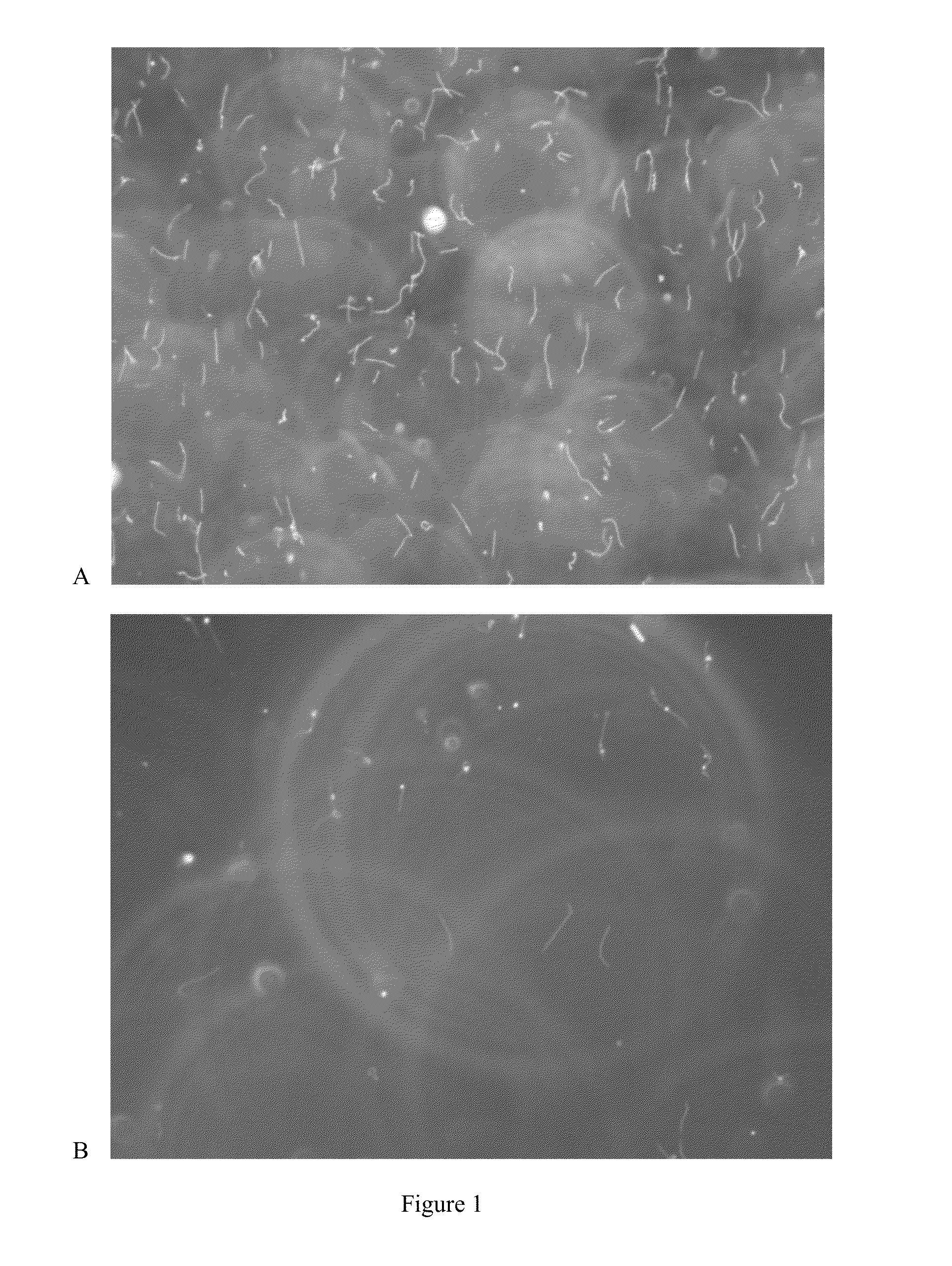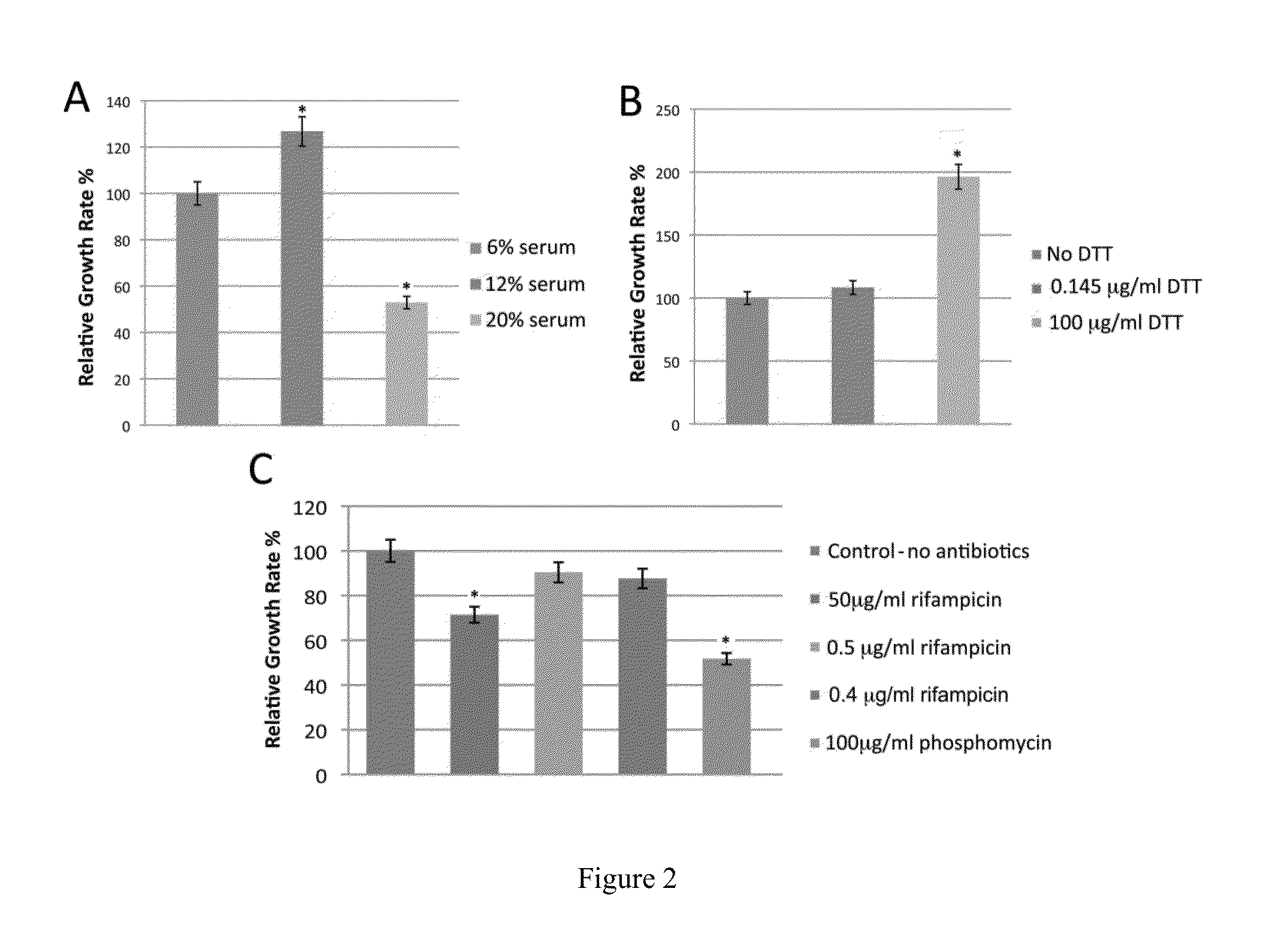Compositions and methods for culturing spirochetes
a technology of spirochetes and spirochetes, which is applied in the field of in vitro methods of culturing spirochetes, can solve the problems of inconsistent results of culturing spirochetes
- Summary
- Abstract
- Description
- Claims
- Application Information
AI Technical Summary
Benefits of technology
Problems solved by technology
Method used
Image
Examples
example 1
Cell Culture Composition
[0236]Spirochetes, including Borrelia, such as Borrelia burgdorferi and Borrelia recurrentis, were grown in the various published spirochete-supporting media. These species were selected as representative of the Borrelia, Treponema, Brachyspira and Leptospira genera, and the results reported below suggest that the methods described herein may be used for these genera. Specifically, 5×106 spirochetes were grown in 12 ml sterile glass tubes containing 10 ml spirochete-supporting medium. The various spirochete-supporting media included Barbour-Stoenner-Kelly-H medium (BSK-H medium) with 6% rabbit serum (available commercially from Sigma Chemical Co., St. Louis, Mo.); BSK-II medium. (described in Barbour, A. G. 1983. Yale J. Biol. Med. 57:521-525); modified Kelly medium (MKP medium, described in Preac-Mursic, et al. 1986. Zentbl. Bakteriol. Mikrobiol. Hyg. Ser. A 263:112-118); MPM medium (described in Phillips S E, et al., 1998, Infection, 26(6):364-7); BSK modif...
example 2
Cell Culture Conditions
[0242]Spirochete cultures are typically grown in anaerobic conditions. To determine the effect of environmental oxygen on spirochete growth, Borrelia burgdorferi B31 cells were cultured on solid BSK-H medium and incubated in anaerobic and microaerobic conditions. Environmental oxygen levels were regulated using a BD BBL GASPAK™ environmental system. After 20 days, the surfaces of the BSK-H plates were evaluated for spirochete growth. The anaerobic environment did not yield any visible Borrelia growth, while the microaerobic environment yielded visible colonies on the surface of the culture plates. Colonies from the microaerobic culture plate were picked with a sterile loop, and live spirochetes were observed by dark-field microscopy (FIG. 3).
[0243]In published studies, researchers typically cultured Borrelia species in 5-15 ml glass tubes with tightly closed lids to prevent any gas exchange and maintain an anaerobic environment. To determine the effect of cult...
example 3
Long Term Spirochete Culture
[0249]As described in Example 2, 50 clinical cultures were grown using the short-term conditions. The cells maintained their spirochetal structure through 6 days of culture. See, e.g., FIG. 4A. After about 10-12 days, the spirochetes in each and every culture converted into different morphological forms and all attempts to revert them back to spirochete form failed. See, e.g., FIG. 4B. Attempts to revert the spirochetes tested the various published spirochete-supporting medium, the amount of medium, culture temperature, CO2 concentration, culture tube size, and culture tube composition (e.g., glass and polystyrene), as described in Examples 1 and 2. Most frequently, spirochetes converted into spheroplast form, as well as different round body forms (granules, cysts).
[0250]Accordingly, the culture conditions were changed prior to the morphological conversion in an attempt to prevent the conversion. Because Borrelia is a symbiotic organism, an environment mi...
PUM
| Property | Measurement | Unit |
|---|---|---|
| concentration | aaaaa | aaaaa |
| concentration | aaaaa | aaaaa |
| humidity | aaaaa | aaaaa |
Abstract
Description
Claims
Application Information
 Login to View More
Login to View More - R&D Engineer
- R&D Manager
- IP Professional
- Industry Leading Data Capabilities
- Powerful AI technology
- Patent DNA Extraction
Browse by: Latest US Patents, China's latest patents, Technical Efficacy Thesaurus, Application Domain, Technology Topic, Popular Technical Reports.
© 2024 PatSnap. All rights reserved.Legal|Privacy policy|Modern Slavery Act Transparency Statement|Sitemap|About US| Contact US: help@patsnap.com










